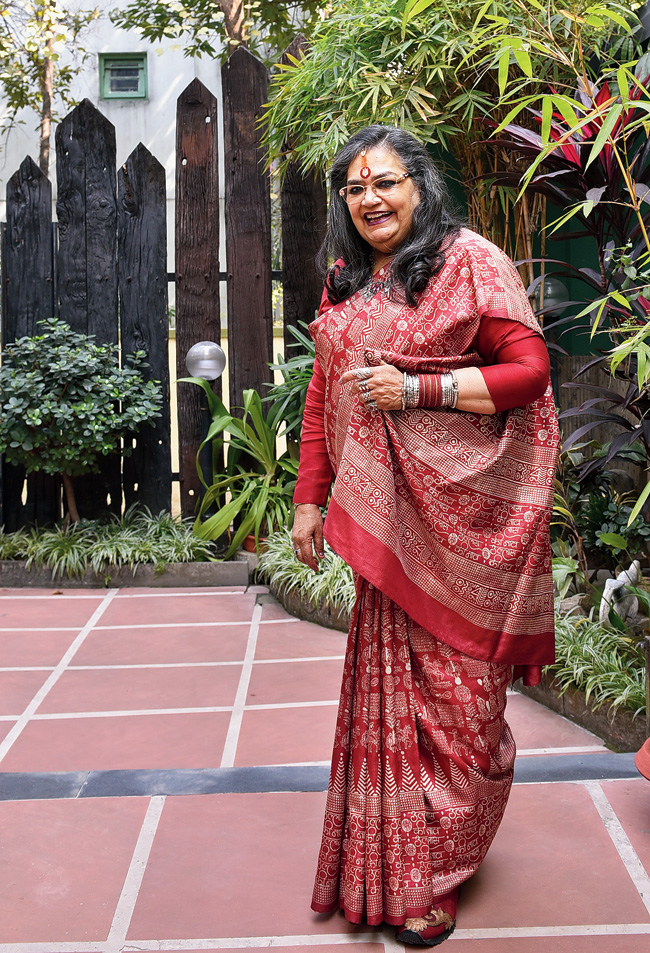On August 15, 1970, she started her own boutique line with just a table, chair and a printer in her garage. Her drawing room was transformed into a display room. Nandita Raja’s Kanishka’s is now a household name. The Telegraph caught up with the lady behind Kanishka’s for a quick chat.
The journey: I started it as a hobby. I used to be home all the time because my son, Kanishka, was small. During my school and college days I used to love making designs. In fact I used to have scrapbooks. My husband, Dilip Raja, asked me to do something about my hobby. I started my business in a garage with just one table, chair and a printer.
Every business has ups and downs. At the beginning I used to do everything, which was tough. No one agreed to teach me anything. I went to Serampore to learn block printing. Then I started thinking about the material for block print. I thought of doing it on Bengal’s taant. People at Serampore told me about this haat at Howrah, called Mangla Haat where all taatis come. So I woke up early morning and visited Mangla haat for material.
I did not imagine that my hobby could turn into my profession. Initially it was my friends and relatives who used to buy and then gradually it became what it is now. I have proved to the world that one can turn hobby into a profession.
Memories: While printing it came to my mind that why not tap the looms. We loved travelling to interiors of places. On one such trip, we went to the interiors of Odisha. On our way we saw this cluster of mud huts… around seven of them. In front of one hut they had given a sari to dry. What attracted me was the colourful anchal. I got down from my car to check who it belonged to. I realised all seven houses in that village, Bomkai, wear similar kind of taant sari. They told me that the saris are made in that village itself. The sari is thick but the anchal of all the saris were exceptionally beautiful. When I asked them where they sell, they told me that they make towels and sell them but the saris are made for the women of the community. The women of that village didn’t wear undergarments, hence the saris are made of thick material. The village was near the Odisha and Andhra Pradesh border. I barely understood their language, but we had a local guy with us who helped. What I loved was they drew inspiration from nature and created the designs like tribal people, bird and hunters. They use natural colour, with no chemical mixed.
Sticking to classics: I am a strong believer of tradition. I don’t run behind the ever-changing trends. In fact, my customers also don’t look for trends. Long time ago I had tried making a line of saris with zari and sequins. None of the customers bought them. They were like, “If we have to buy this kind, we will go to AC Market not Kanishka’s. We come here for your original work”.
Challenges: The biggest challenge is to keep handloom alive. Amidst digital printing and other techniques, but I still believe in block prints. Manually we still apply paints on blocks and print it on materials. This will never change in Kanishka’s. Trends stay for a period of time, but this tradition will always be alive. It becomes expensive but my customer values it. I don’t believe hand-woven and hand-prints are a dying art. This will always stay in our country.
The next generation is studying in good designing colleges and are learning different kinds of techniques. I just hope they don’t forget the tradition. Along with the modern methods, they should keep these traditional methods alive.
The Future: I want to teach someone from the next generation. I had given lessons to someone who used to be there in my showroom from 1988. Now she is very well trained. I am looking for more young people who are ready to learn. I want this to go on even after me. My son and daughter-in-law (Prateek and Priyanka Raja) are busy so they will not be able to help me out in future. They might see overall but for the workshop to go on I want to teach interested young people.

Hair and make-up: Abhijit Chanda, Pics: B. Halder
In celebration of 50 years of Kanishka’s, actress June and singer Usha Uthup posed for The Telegraph in creations by their favourite Kanishka’s
Newly-wed Tolly star June, draped in a black-and-white block-printed cotton sari, spoke about her memories of Kanishka’s. “I have grown up seeing my mom (Parul) and grandmother (Monorama) wearing saris from Kanishka’s. The block-printed cotton saris used to be mom’s favourite. Every year she used to buy a set of them for the summer. She used to look forward to the colours and prints because Kanishka’s is famous for that. Quite a few saris have been passed down to me as well. The first name that comes to mind when we talk about block-printed cotton saris, is Kanishka’s. The most beautiful part of Kanishka’s is that they have held on to their tradition over 50 years,” said June.
Next, she got into an elegant sari, which she wore in dhoti-style, paired with a black top. “My first buy from Kanishka’s was for my mother on her 50th birthday. I had picked up a nice silk gadwal and south cotton. That was the first time I independently went to the store and bought with my money. Ever since that I have bought quite a few saris and kurtis for myself and kurtas for my son. Their men’s collection is equally good. I also buy their printed materials and stitch them into blouses,” said June.
“My mom had gifted my boro mashi a lovely tussore from Kanishka’s, which I wore and walked the ramp at CC&FC where we celebrated Kanishka’s 25 years. It was passed down to me after my boro mashi passed away. I still wear it because these are like masterpieces and never go out of fashion,” she added after the shoot.
Usha Uthup posed in a Kanishka’s sari for The Telegraph. “Kanishka’s is a part of me. My bond with Nanditadi (Raja) and her husband, Dilip Raja, became even stronger when Kanishka’s did a sari for me on my song Kolkata Kolkata. Since then I have given them the lyrics of the songs I have sung and they printed it for me, like Bombay meri hai, Ente Keralam ethra sundaram, and Jo kuch bhi ho jaye, in tussore and mulmul saris. Everywhere people loved these saris. Nobody has the designs like Kanishka’s, which makes designs iconic and sophisticated. I love the earthy colours… the deep maroons, rusts, off-white, black, purple. It has been a great journey for Kanishka’s. I cannot imagine my cupboard without my Kanishka’s collection,” said the veteran singer.

